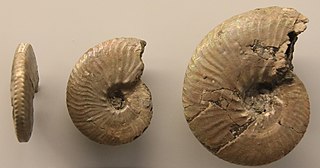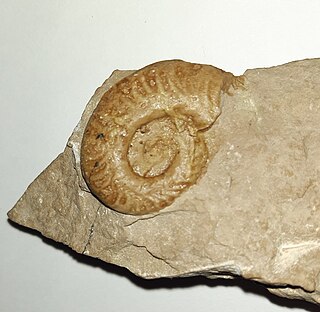
Anahoplites is a genus of rather involute, compressed hoplitid ammonites with flat sides, narrow flat or grooved venters, and flexious ribs or striae arising from weak umbilicle tubercles that end in fine dense ventrolateral nodes. The elements of their sutures are short, wide and jaggedy. Specimens of Annahoplites have diameters typically in the range of 4–6 centimetres (1.6–2.4 in) although some with diameters of as much as 19 centimetres (7.5 in) have been reported. The genus lived during the Cretaceous, from the Middle to the late Albian.

Arnioceras is an extinct genus of large, evolute, discoidal ammonite from the Lower Jurassic. The shell is normally coiled so that all whorls are exposed. Sides bear strong sharp ribs that are straight until reaching the ventrolateral edge where they swing forward and fade. The rim (venter) is keeled and free of grooves.
Frenguelliceras is an ammonite genus from the Lower Cretaceous included in the perisphinctoid family Neocomitidae named by Leanza in 1945. The type species, F. magister, is from the Valanginian,(Lower Cretaceous), of Argentina.
Fournierella is a member of the Muniericeratidae, a family of Upper Cretaceous ammonites characterized by moderately evolute shells with strong sinuous ribs that have tubercles on the shoulders and umbilical edge, and a more or less fastigate cross section, included in the Desmocerataceae. It may be a subgenus of Pseudoschloenbachia.

Hildoceras is a genus of ammonite from the Jurassic period in the family Hildoceratidae. The shells are characterized by a narrow discoidal evolute shape, keeled venter, concave ribs along the outer flanks, and a shallow spiral groove running along smooth inner flanks. Whorls slightly overlap, cross sections are compressed. The ventral keel is bordered on either side by a shallow groove. The genus was named by Alpheus Hyatt after Saint Hilda in 1876.

Collignoniceratidae is a family of Upper Cretaceous ammonites characterized by typically more or less evolute shells with compressed, oval, or square whorl sections; serrate or entire keels; and dense ribs with one to 5 tubercles.

Acanthoceratoidea, formerly Acanthocerataceae, is a superfamily of Upper Cretaceous ammonoid cephalopods belonging to the order Ammonitida, and comprising some 10 or so families.
Pachyceratidae is a family of Perisphinctoidean ammonites from the upper Middle - and lower Upper Jurassic. Genera within the Pachyceratidae have shells that are in general moderately involte but with most of the inner whorls exposed; whorl sections subquadrate to subtrapezoidal, with rounded venter. Ribbing is strong, in some sharp. Primary ribs typically branch above mid flanks into twos, threes, and even fours.
Shloenbachiidae is a family of hoplitoid ammonoid cephalopds mostly from the lower Upper Cretaceous,.
Callihoplites is a genus of rather evolute ammonites from the Lower Cretaceous, Late Albian. Its whorl section squarish or compressed, inner whorls bearing umbilical bullae and ventrolateral clavi, with or without looped ribs between. The body chamber is smooth with a rounded venter.
Brancoceras is a rather small, strongly ribbed, acanthoceratacean ammonite from the Albian stage of the Lower Cretaceous, the shell evolute with a subquadrate whorl section and rounded venter. The suture forms a finely squiggly line with well-defined lobes and saddles. Brancoceras (Eubrancoceras) aegoceratoides reached a diameter of at least 4.2 centimetres (1.7 in).
Brancoceratidae is a family of acanthoceratoid ammonites from the middle of the Cretaceous, recognized by their commonly evolute shells with round, oval, or quadrate whorls, strong ribs, usual ventral keels, and at least, umblical tubercles. The family is thought to be derived from the Desmoceratidae (Desmoceratoidea), perhaps from Silesitoides or some allied genus.
Pseudohaploceras is a genus of desmosceratid ammonites from the Early Cretaceous; Valanginian to Albian epochs.
Melchiorites is a desmoceratid ammonite genus included in the subfamily Puzosiinae. Member species are characterized by an essentially evolute shell in which the early whorls are smooth, with sinuous radial or oblique constrictions but in which later whorls have feeble intermediate ribs on the outer part of the sides and venter.

The Acanthoceratinae comprise a subfamily of ammonoid cephalopods that lived during the Late Cretaceous from the latter early Cenomanian to the late Turonian
Tragodesmoceras is a large moderately involute ammonite with deeply embracing whorls that are higher than wide, a steep sided umbilicus and a narrowly rounded venter. Ornament consists of primary ribs that begin at the umbilical shoulder and smaller secondary ribs that begin mid flank. Ribs are sigmodal, periodically thickened and bent forward on the outer flank to cross the venter as chevrons. The suture has a broad trifid lateral lobe.
Cunningtoniceras is a stocky acanthoceratid ammonite from the upper Cenomanian stage of the late Cretaceous of the western U.S., found e.g. in Arizona and New Mexico.
Neocardioceras is a genus of evolute acanthoceratid ammonites from the uppermost Cenomanian, Upper Cretaceous, of Europe, western U.S. and Brazil.
Euomphaloceras is an early Upper Cretaceous ammonite genus,, included in the Acanthoceratinae until established as the type genus for the Euomphaloceratinae by Cooper, 1978.
Flickiidae is a family of dwarf ammonites with little ornament and very simples sutures known from small pyritic specimens found in middle Cretaceous deposits. Inclusion in the Acanthoceratoidea is tentative.





